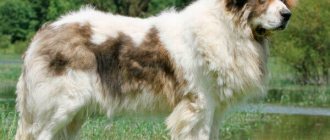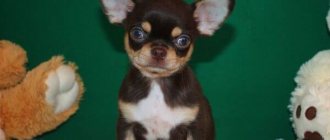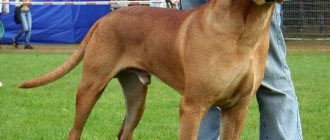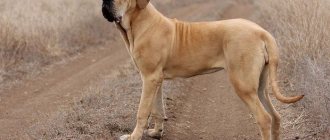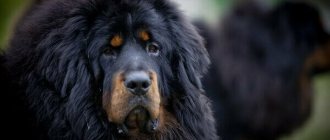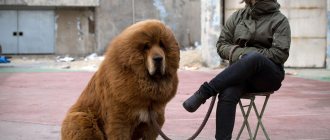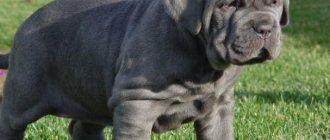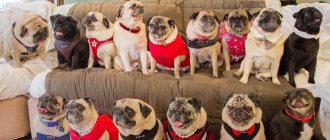The name “mastiffs” unites a large group of breeds, which includes Tibetan, English, French, Spanish, South African, Pyrenean, American, Japanese and other varieties of similar dogs.
There are many rumors about the Fila Brasileiro breed.
It is prohibited in some countries, and in others you simply cannot own a dog without a certain document.
What is special about the Brazilian Mastiff?
Why are there so many prejudices about this breed, and how true are they?
Before getting such a dog, you need to carefully understand everything so as not to be deceived and know exactly what to expect from a Brazilian Mastiff.
Origin story and what it looks like in the photo
It is not known exactly how the Brazilian Mastiff came to be.
At the same time, there are several versions of its origin.:
- According to the first version, this breed was the result of crossing a bulldog, an English mastiff and a bloodhound. This point of view makes sense; it cannot be considered absurd. In the Brazilian Mastiff, the traits of these breeds are indeed visible, and quite clearly. This is visible not only in appearance, but also in other characteristics of the dog.
- The second version says that the ancestors of the Fila Brasileiro are the Molossians brought to Brazil by the conquistadors. Breeds of this variety were mixed with each other, resulting in the Brazilian Mastiff.
Veadeiro pampeano
The Veadeiro pampeano is a medium-sized dog with a rectangular body and rustic appearance. These dogs are said to have worked as hunters in the countryside. These dogs were known to be ruthless hunters with incredible sniffing abilities. Like a good hunting dog, the veardeiro has very keen senses and is always alert to stimuli in your surroundings . His disposition is balanced and obedient, which makes him easy to train. These dogs are extremely loyal to their guardians and very patient with children. However, they can be distrustful or hostile in the presence of strangers. Therefore, it is a race that requires special attention when it comes to early socialization...
According to CBKC, the breed has been present in the southern region of Brazil since the 19th century, but has not yet gained FCI recognition.
.This
Interesting Facts
- The Brazilian Mastiff is one of the most dangerous breeds in the world due to its hot-tempered and impulsive nature;
- Breeding this breed is prohibited in many countries in Europe and other parts of the world;
- The Brazilian Mastiff is a very loyal dog to its owner. In Brazil there is even a saying: “Loyal as a fila!”;
- The breed first came to Russia in 1922. The first representatives were called Alaketus Dardo and Alaketus Ingrid.
Description of the breed
This breed is very strong and muscular..
The physique is proportional: a large head with floppy ears, a thick neck, a strong body with a deep chest and convex ribs. Under the neck there is a fold of leather.
The eyes are located far from each other and are of medium size . The color of the iris depends on the color of the animal, and can vary from yellow to dark hazel.
If the dog is in a calm mood, the skin falls on the eyes, giving the impression that the dog is sad.
The limbs are smooth and equally muscular; there are no dewclaws on them . The tail is strong and wide at the base. There may be folds on the body, but not on the forehead. Dogs' coat is short and can be of different colors, except black, spots are allowed.
A distinctive feature of the Fila is the “camel step” - they move simultaneously with two limbs of one side. Thanks to this property, representatives of the breed can move with minimal energy expenditure.
Historical reference
First of all, let’s dispel the misconception that the Belgian Malinois is related to France. The short-haired line of shepherd dogs was bred in the Flemish region, which is part of Belgium. Previously, before the formation of the official Dutch and German languages, French and its dialects were briefly used in the region. This is why some city names and names are written and pronounced in the French manner.
This is interesting! In 1882, one of the most influential cynological unions in Belgium, the Society of St. Hubert (SRSH), was founded.
Upon closer examination of the history of the breed, it can be assumed that the Malinois still has international roots. The notes of Louis Hugebaert (honorary member of SRSH) contain data on short-haired mestizos of the aboriginal type living on the border of the modern Netherlands and Belgium. Simply put, under the guidance of shepherds and nature, shepherd dogs were bred in a limited area through primitive selection. The dogs had a stable gene pool, were similar in appearance and fit into the primary standard of the Belgian Shepherd breed.
The similarity of the dogs was discovered by chance, during a small rural exhibition, where shepherds showed off their charges and were looking for dogs for mating. Mr. Hugebaert was present at this review, which promoted the Malinois to the title of national shepherd. At first, the breeding club was nothing more than a group of enthusiasts who appreciated the abilities of four-legged animals. To the surprise of people, the breed quickly stabilized and was successfully bred.
This is interesting! The name Malinois came into use 20 years after the start of breeding work.
By 1898, breeders founded the first official Malinois club, which became part of the Belgian Shepherd Cynological Union. Three years later, a male named Vos des Polders was entered into the stud book. Red dogs were often called Vos, which means Fox; the most famous shepherd dogs were:
- Vos des Polders is the first registered Malinois.
- Vos I and Vos are the ancestor and champion of Laekenois.
- Vos de Laeken - brother of Liske de Laeken and also the ancestor of Laekenois (exact pedigree unknown).
Using existing dogs and involving in breeding work producers with good conformation, but without documents, the breeders went the following way:
- From the mating of Vos des Polders and a female from the Liske de Laeken litter, Dewet was born - a stately male, with beautiful deer hair and a black mask, the first “fundamental sire” of the breed.
- During the same period of time, the ancestor Diane was obtained from the mating of Vos I and Liske.
- In turn, from mating with Samlo, Diane gave birth to a wire-haired male, Tomy (Laekenois). Samlo is registered as a shepherd of unknown origin with a brown-red color, black mask and excellent working qualities.
- Cora I, a female of unknown origin, of suitable color and conformation, was bred to Tomy, resulting in Tjop, the second male who became the origin of many Malinois lines.
Today, the working skills and characteristics of the breed allow the Malinois to be used in all special services. “Belgians” take first place in tests, serve in the army and police, search for people and chemicals, and work as guides. Frankly speaking, the Malinois is actively replacing the German Shepherd even in Germany.
Character traits
In relation to Fila, there are different versions regarding her character.
Many breeders and owners claim that the dog is aggressive and can attack a person . There is truth in this statement, because initially the breed was used to guard slaves and livestock.
But the dog never shows unreasonable aggression. She is very suspicious of strangers, but will never attack unless the threat is a threat to her master, whom she reveres and idolizes. Also, the dog will always defend its territory.
Strangers should not come up and just pet a Brazilian Mastiff, he definitely won’t like it . In a family, the dog behaves peacefully and friendly.
It will not offend a child growing up in the house. This breed is also very empathic. She will always feel what the owner needs at one time or another. In difficult times, this dog will always come to express his support.
Also, this breed becomes very attached to only one person in the family . For the Fila, the owner is the authority and the only one who deserves true loyalty and submission.
For this reason, you should not give the dog to other people when it is already accustomed to the family. This could turn into a real tragedy.
Expert opinion
Kozhevin Semyon Kirillovich
Expert dog handler.
“This breed has a very developed watchdog and protective instinct. If someone suddenly wants to enter his territory, the dog will attack without hesitation. He clearly distinguishes “us” from “strangers”. That is why he is always wary of strangers and always expects a trick. In the family circle, with the right upbringing, he will never show anger or aggression, even if he is greatly offended. It’s impossible to call this breed a completely family breed, because you can’t walk with it in a crowded park. But the mastiff loves and protects his household and will never let them be offended.”
Brazilian Bulldog
The Dogo Brasileiro (or the dogo brasileiro) comes from crossing a male bull terrier and a boxer. His creation is attributed to Pedro Pessoa Ribeiro Danta , the famous Brazilian creator of the Bull Terrier breed in the 60s and 80s. However, popular history claims that it was actually Danta's neighbor who asked him to cross one of his male bull terriers with the neighbor's boxer. , so, in 1978, the first Brazilian bulldog dogs were born. It was the first dog breed from Brazil to be created in an urban environment...
Danta was left with one of the puppies born on this cross. When he noticed that the puppy was very healthy with a strong, agile and elegant body, demonstrating obedience and a predisposition to exercise, Danta decided to continue training this dog. The breeder originally christened the breed the name Bull Boxer , as a tribute to his parents.
In the twentieth century, the Bulldog of Brazil was recognized by the Brazilian Confederation of Dogs (CBKC). The breed is now getting closer and closer to FCI recognition.
Advantages and disadvantages
Advantages:
- Will stand up for family members;
- Sensitively guards the territory;
- Loyal to the owner;
- Treats “his” children well;
- Very smart and easy to train;
- Does not require much attention and careful care.
Flaws:
- Absolutely unfriendly to strangers and other people's children;
- Despite easy care, maintenance can cost a pretty penny;
- Stubborn dog, obeys only a person with impressive authority;
- Shows aggression if he sees even the slightest provocation;
- He drools and snores loudly.
Pet standard
The International Canine Standard specifies all the necessary signs and characteristics of the Brazilian Mastiff: body build, color, structure of body parts and character. According to the description, this is a Molosser with large bones and a harmonious body build.
The standard specifies the two most important characteristics of Fila Brasileiro:
- The skull is longer than the muzzle;
- The length of the body should be longer by 10% of the dog's height.
The head is massive, with a wide skull, the upper lip covers the lower lip, and is in a drooping state. The forelimbs are more powerful than the hind limbs, the skin hangs freely. The coat is short.
The standard also indicates shortcomings and defects . Some of them include a short muzzle, too light eyes, a sagging or hunchbacked back, weak bones, many white spots on the coat, etc.
Appearance
The Malinois is not the largest and fastest line of the "Belgians", this place is occupied by Tervuren, but this does not at all reduce the working value of the dog. Not too large, lean, flexible, muscular shepherd dog can give odds to many in any ring and test. Medium dimensions make the Malinois more resilient. The dog is proud and graceful when viewed, but can turn into a fearless beast if the owner is in danger. Belgian Shepherds are medium in size. Depending on gender, height and weight are:
- Male: 60–66 cm; 26–30 kg.
- Female: 56–64 cm; 20–26 kg.
Important! An apathetic, shy, and even more so cowardly or aggressive dog is excluded from participation in exhibitions and breeding work.
The head is proportional, visually it may seem elongated. The back of the head is rounded, the forehead is sloping, smoothly turning into the bridge of the nose. A faint dividing furrow runs along the forehead and bridge of the nose. The almond-shaped eyes are lively and very intelligent. The eye sockets are not expressed, but the eyebrows are mobile and expressive. The color of the iris is dark brown, rich. The ears are raised high, open, triangular, well rounded. The bridge of the nose is smooth and tapering. The nose is black and wide. The lips are tight fitting and not droopy. Lip pigmentation is rich, black, without light spots. The bite is correct, without a gap between the incisors (scissor bite). The neck is beautifully arched and muscular, giving the impression of a proud head carriage. The withers are pronounced, but not conspicuous. The skin on the neck is taut (without folds).
Note! The Malinois has an excellent sense of smell; the dog's nose is constantly moving, even if the four-legged dog looks at ease.
The paws are well developed, strong with prominent muscles. The elbows are parallel to the body, the movements are free and sweeping. The hips are wide and very strong. The hock joints are parallel, pronounced, but proportional. The articulation of the hock joint is inclined towards the surface on which the dog is standing, which creates a feeling of “springiness” in the paws.
The body of the Malinois is strong and muscular. Males tend to have a more square format. Boughs can be elongated. The chest is moderately wide, but deep (up to the elbow line), the ribs are arched and well elongated. The back is uniformly wide and level. The shoulder girdle is strong and wide, the croup is rounded. The tail is proportionally wide and set moderately high. Carried low or at the level of the spine, the tip is curved.
If you look at photos of old-format German Shepherds and Malinois, you will find many similar criteria. These are today German Shepherds, elongated and literally crawling along the ground. At the time of the formation of the Malinois, the dogs were very similar - small, smart and hardy.
Is it suitable for keeping outdoors and in apartments?
A dog can easily be kept both in an apartment and in a country house, on a plot. She will be equally comfortable, but the site, of course, is the most desirable.
In an open space, the Fila will be able to show the full potential of its security and watchdog qualities . She can be kept in an enclosure, but also allowed to run around the yard, for example, at night, when the house is most in need of protection.
Also, in the fresh air, if possible, the dog will be able to occupy itself on its own, but this does not mean that it does not need to be exercised. Even on the site, you will need to train and train the dog.
If you have chosen an apartment for keeping, then you need to be sure that the dog gets enough hours outside.
NOTE!
Moreover, you need to not only walk with him, but also train him, hone your already learned skills.
This is also important for adaptation, otherwise the Fila will be quite aggressive towards all passers-by, as well as other dogs.
No matter how much you trust your dog, you should only walk it on a short leash and muzzle, except in places where it cannot pose any danger to others.
Dog names
If the purchase of the puppy was not planned in advance, that is, you did not agree on the upcoming litter, then most likely you will be given documents along with the puppy, where his name will already be indicated. Otherwise, you will have the opportunity to choose your own name for your future pet. It is better if it is a name that emphasizes the power and intelligence of the dog.
Try not to give nicknames that sound like teams or human names. In this case, the dog will get confused and take a long time to get used to its nickname, or respond to the call of passers-by.
Examples of nicknames suitable for Phil:
- for males - Bronko, Klim, Dovlad, Bishka, Boston, Zorli;
- for bitches – Ressi, Di-di, Pilet, Agen, Marley, Alania.
Attitude towards children and pets
Fila Brasileiro loves children, but only those with whom she grew up, or who grew up next to her . She does not show aggression towards them, she even plays and tolerates their play on her.
But we must remember that there may be a limit to any patience, and leaving a child alone with such a large dog would be reckless and imprudent.
The dog is very wary and suspicious of other people’s children, and can snap and growl, so you shouldn’t let them near the dog or expose them to any risk..
If the socialization stage is completed correctly, the dog will not show aggression towards pets, especially if it grew up next to them.
Small pets are another matter, at the sight of which a dog’s hunting instinct may awaken. We must remember that dogs are different.
Some can quite easily get along with our smaller brothers, while others will not allow the presence of any stranger on their territory or in their home, even if he does not pose a threat.
Training
Cleverness and intelligence are some of the character traits of the Brazilian Fila. The dog quickly undergoes training and always knows what is required of it. To understand the life principle of this breed, you just need to take into account that the Fila follows the pack principle, where the main one is the leader, to whom everyone obeys. Accordingly, you need to be a leader, otherwise the dog will dominate and show aggression.
Initially, Brazilian filas were used to hunt dangerous predators
The Brazilian Fila was bred to guard and hunt a large predator - the jaguar. Dogs of this breed have a strong temperament, a complex character, and require respectful treatment. To properly train this breed you need to have a lot of experience and know everything about the dog and its nervous system. Early socialization is mandatory for the Fila to avoid conflicts on walks with other dogs. When walking, it is not advisable to let the Fila off the leash, and you should not encourage hunting instincts if the owner does not have the opportunity to take the dog hunting.
Fila dogs are vulnerable, so there is no need to use physical force if the dog does not follow a command. It is better to use other methods, for example, encouragement, and then his character will be more balanced and calm. The Brazilian Fila is a devoted friend and, above all, your personal guard, so the dog loves to spend time in the company of its owner for days, no matter how much you resist it.
Despite their tough character, Brazilian Phils are very vulnerable
What do you need to know? When walking your Fila Brasil, you must be strictly wearing gear and away from playgrounds and other dog walks. In this way, you can avoid aggression on the part of your pet directed at other dogs or people.
Video - About the Brazilian Fila breed
How to properly care
Caring for a Fila Brasileiro does not require much time or effort, but it is necessary..
- Monitor the condition of your dog's skin. She has short hair. There is no need to bathe often, just use the furminator from time to time;
- Every few days, wash your dog’s folds with a cloth soaked in warm water;
- Every morning you need to wipe your dog’s eyes with chamomile infusion;
- Inspect your dog’s ears; you need to clean them at the end of the week, but not with cotton swabs, but with a special swab;
- Nails need to be trimmed as they grow;
- You need to walk your dog two or three times a day for several hours. Don't forget about certain physical activities: the dog needs to splash out.
If a dog lives in a plot or enclosure, this does not mean that it does not need your attention. Without an owner, the breed quickly withers and becomes lethargic.
Hovawart care
In general, the Hovawart is suitable for keeping in an apartment, but it needs a lot of space to move. Here, at least, the dog’s protective instinct can be realized, because there is a specific owner’s territory that can be walked around. In such conditions, the Hovawart will need to be walked for many hours every day, so that walks will literally bring him to exhaustion. Of course, it is difficult for the average owner to fulfill this requirement.
In this regard, an enclosure will also not satisfy the dog’s needs, even if you walk it for at least 2 hours in the open air. The Hovawart is absolutely not suitable for keeping on a chain. Here, not only physical activity will suffer, but also the animal’s psyche.
The dog is ideal for a private yard, where it will fully demonstrate its breed's protective qualities, having room for free movement and constant walking around the entrusted territory. But the owner must provide this territory with a high fence: the Hovawart jumps well and quickly attacks the intruder without waiting for the owner’s command.
A private yard with a high fence is an ideal place to keep a Hovawart.
Wool
At first glance at the long wavy coat of the Hovawart, it seems that it is precisely this that requires constant care. But that's not true. The dog's fur has water-repellent properties and practically does not get dirty. Therefore, Hovawarts are bathed 3-4 times a year, or as they become dirty, if the fur begins to give off an unpleasant odor.
But you need to comb your pet 1-2 times a week to prevent the formation of tangles. During the molting period, this procedure is performed daily.
Claws, ears and teeth
Unlike fur, claws, ears and teeth require more attention from the Hovawart owner.
The dog’s teeth are brushed, like other breeds, once every 7–10 days. To do this, use a special brush and paste.
A working dog does not need to trim its nails; they wear down naturally. They are only regularly inspected for chips and cracks. For domestic (and even more so for exhibition) specimens, the procedure is carried out once every 2 weeks. It is better to accustom the Hovawart to trimming its claws from puppyhood, then the procedure will be accepted by the pet calmly.
Once every 2 weeks, the pet’s ears are also cleaned. They are also checked for parasites. Thus, an unpleasant odor or discharge should prompt you to consult a veterinarian.
Nutrition
The young Hovawart dog is growing at a rapid pace. In addition, dogs of this breed are generally very active, therefore, nutrition should provide them with building material for muscles and bones, and the necessary energy.
Breeders recommend feeding Hovawarts with dry food. It should be at least premium class, ideally super premium or holistic. Such nutrition will provide all the body's needs; additional vitamin and mineral supplements are not required.
Hovawarts do not have a breed tendency to allergies or digestive disorders, so the owner can choose food depending on the pet’s own capabilities and preferences. But dogs of this breed are food lovers, so the owner should strictly follow the recommendations of the food manufacturers.
The following are suitable for feeding the Hovawart:
- Acana;
- Almo Nature Holistic Adult Dog Large;
- Barking Heads;
- Orijen;
- Pronature Original.
With natural nutrition, the owner will have to balance the diet himself and add vitamin and mineral components to it. Here it is better to consult a veterinarian.
In general, feeding Hovawarts does not differ from the diet of dogs of other large breeds:
- The basis of the menu should be lean meat (2/3 of the diet), the rest (1/3) should be plant foods.
- The meat must first be frozen. The fish is cleaned of bones.
- Fruits and vegetables are finely chopped, after removing tops and seeds. They can be given raw or cooked (stewed).
Not suitable for feeding:
- cabbage, potatoes, legumes;
- fatty meat or fish;
- sweets, confectionery, chocolate;
- food with added salt and spices, spicy and smoked.
Like other dogs, the Hovawart needs clean, free access to water. Breeders even recommend taking water with you on walks so that an active dog can satisfy its thirst.
How long does one live and the main diseases?
This breed has good health, but there are diseases to which it is susceptible.:
- Hip and elbow dysplasia;
- Digestive problems (bloating);
- Cardiac ischemia;
- Eye diseases (“cherry eye”);
- Otitis.
On average, an animal lives 10-12 years.
Chinook Health
Despite the fact that the dogs were bred to be resistant to low temperatures, they cannot boast of “Siberian” health. Either from a mixture of many bloods in the breed, or from other unknown reasons, they often suffer:
- allergies - most often it manifests itself as skin rashes and redness of the eyes;
- hip dysplasia - can be manifested by limping, difficulty getting up on their paws after sleep, can be congenital or acquired due to improper feeding or heavy loads (therefore, it is recommended to even walk puppies up to one year carefully, not to the point where the dog gets tired);
- epilepsy - a chronic disease of the nervous system, manifested by convulsive seizures;
- cryptorchidism - undescended testicle into the scrotum in male dogs.
To prevent many diseases, it is necessary to undergo regular examinations by a veterinarian, give your pet all the necessary vaccinations, and treat it against parasites.
The Chinook is a strong and hardy dog, specially bred for sled work in the North. Representatives of this breed have many advantages and only one drawback, which is the rarity of these dogs and the difficulty of purchasing a puppy. But the qualities that Chinooks possess are worthy of their growing popularity. I would like to hope that the breed will follow this path and will finally receive recognition from kennel clubs.
Nutritional Features
It is recommended to feed this breed natural food. This is the only way she receives the entire set of necessary components. The bulk of the products should contain meat; beef or lean lamb is suitable.
Mastiffs can also be given boiled sea fish without bones, cereals, vegetables, dairy products and fruits as a reward . Dogs also need various vitamin supplements.
Due to possible digestive problems, dogs need to be fed several times a day in small portions. After eating, you need a short break.
How to choose and who is better - a boy or a girl?
When choosing a puppy of this breed, contact only specialized nurseries and breeders:
- Evaluate the puppy's appearance. You can already guess the future dog in it;
- The bones should be strong and without defects, the muzzle should not be too short, the skull should be powerful, the forehead should be wide;
- The upper lip of puppies already hangs over the lower lip;
- The tail should be without bends, moderately long, wide at the base;
- There should not be any bald patches on the fur;
- The mucous membranes of a healthy puppy are clean, without discharge, there is no unpleasant odor, there are no seals around the abdomen;
- An adequate puppy is moderately playful, curious, but in no case aggressive or cowardly.
When choosing a puppy, you also need to pay attention to the dog's gender identification.
CAREFULLY!
Boys are more aggressive, they zealously protect the territory and the owner, and can be indifferent to children.
In this regard, girls are more gentle and affectionate, they are more friendly towards children, and they become very attached to them, as if they were their offspring.
You also need to remember that females are at risk of pregnancy and childbirth, and this is an additional burden for both the dog and the person..
Russian nurseries
There are few good nurseries of the Brazilian Fila breed in Russia. It is important to choose a dog from a responsible and honest breeder, then there will be no doubt about the purity and quality of your dog’s breed.
Nurseries of the Brazilian Fila:
- Eden De Sol, Moscow;
- Rey`s Pride, Moscow;
- "Imperio Dorado", Moscow.
Purchasing a puppy
Before buying a Brazilian Fila puppy, you need to evaluate your capabilities in providing the pet with plenty of space and proper attention, since the dog is very large and active, with a complex character. Also, this breed does not like to be silent, and regular barking can tire you and disturb the peace of your neighbors. Fila loves long and frequent walks, so it is better to keep the pet in a private house with an enclosure.
In Russia there are very few good nurseries with pure breeds of Brazilian Fila. It is worth making a considerable effort to find an experienced and responsible breeder. On average, the price for Brazilian Fil puppies is from 30,000 rubles.
Buy a puppy only from specialized nurseries, having first studied detailed information about the breeder. Never buy a puppy from private individuals on the Internet.
